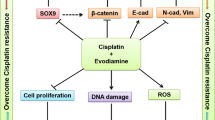Abstract
Dipyridamole (DP), a clinically used vasodilator and an antiplatelet compound, augmented the activity of the anticancer drug mitoxantrone (MXN) toward Chinese hamster ovary (CHO-K1) cells in culture. Clonogenic assays indicated that DP (1.0, 2.5, and 5.0 µM) decreased the survival of cells treated with MXN (5 to 25 nM) in a dose-dependent manner. Further, DP (1 and 5 nM) decreased the MXN concentration required for 50% inhibition of cell growth from 3.2 to 1.8 and from 3.0 to 0.5 nM, respectively, over a period of 3 days. DP (10 µM) increased the accumulation of MXN by 1.8-fold in exponentially growing cells exposed to MXN. The enhanced levels of MXN in CHO-K1 cells in the presence of the chemosensitizer may account for the potentiation of MXN-cytotoxicity by DP.
Similar content being viewed by others
REFERENCES
K. C. Murdock, R. G. Child, P. F. Fabio, R. B. Angier, R. E. Wallace, F. E. Durr, and R. V. Citarella. Antitumor agents. I. 1,4-Bis[(aminoalkyl)amino]-9,10 anthracenedione. J. Med. Chem. 22:1024–1030 (1979).
I. E. Smith. Mitoxantrone (Novantrone): A review of experimental and early clinical studies. Cancer Treat. Rev. 10:103–115 (1983).
T. I. Poirier. Mitoxantrone. Drug Intell. Clin. Pharm. 20:97–105 (1986).
J. Koeller and M. Eble. Mitoxantrone: A novel anthracycline derivative. Clin. Pharm. 7:574–581 (1988).
G. T. Bowden, R. Roberts, D. S. Alberts, Y. M. Peng, and D. Garcia. Comparative molecular pharmacology in leukemic L1210 cells of the anthracene anticancer drugs mitoxantrone and bisantrene. Cancer Res. 45:4915–4920 (1985).
P. A. Paciucci, T. Ohnuma, J. Cuttner, R. T. Silver, and J. F. Holland. Mitoxantrone in patients with acute leukemia in relapse. Cancer Res. 43:3919–3922 (1983).
J. A. Nelson and S. Drake. Potentiation of methotrexate toxicity by dipyridamole. Cancer Res. 44:2493–2496 (1984).
J. L. Grem and P. H. Fischer. Augmentation of 5-fluorouracil cytotoxicity in human colon cancer cells by dipyridamole. Cancer Res. 45:2967–2972 (1985).
Y. S. Zhen, M. S. Lui, and G. Weber. Effects of acivicin and dipyridamole on hepatoma 3924A cells. Cancer Res. 43:1616–1619 (1983).
T. C. K. Chan, M. Markman, S. Cleary, and S. B. Howell. Plasma uridine changes in cancer patients treated with the combination of dipyridamole and N-phosphonacetyl-L-aspartate. Cancer Res. 46:3168–3172 (1986).
J. K. V. Willson, P. H. Fischer, K. Tusch, D. Alberti, K. Simon, R. D. Hamilton, J. Bruggink, J. M. Koeller, D. C. Tormey, R. H. Earhart, A. Ranhosky, and D. L. Trump. Phase I clinical trial of a combination of dipyridamole and acivicin based upon inhibition of nucleoside salvage. Cancer Res. 48:5585–5590 (1988).
G. T. Budd, A. Jayaraj, D. Grabowski, D. Adelstein, L. Bauer, J. Boyett, R. Bukowski, S. Murthy, and J. Weick. Phase I trials of dipyridamole with 5-fluorouracil and folinic acid. Cancer Res. 50:7206–7211 (1990).
H. Kusumoto, Y. Maehara, H. Anai, T. Kusumoto, and K. Sugimachi. Potentiation of adriamycin cytotoxicity by dipyridamole against Hela cells in vitro and sarcoma 180 cells in vivo. Cancer Res. 48:1208–1212 (1988).
S. B. Howell, D. Hom, R. Sanga, J. S. Vick, and I. S. Abramason. Comparison of the synergistic potentiation of etoposide, doxorubicin and vinblastine cytotoxicity by dipyridamole. Cancer Res. 49:3178–3183 (1989).
S. B. Howell, D. K. Hom, R. Sanga, J. S. Vick, and T. C. K. Chan. Dipyridamole enhancement of etoposide sensitivity. Cancer Res. 49:4147–4153 (1989).
T. D. Bjornsson and C. Mahony. Clinical pharmacokinetics of dipyridamole. Thromb. Res. Suppl. IV:93–104 (1983).
C. Mahony, K. M. Wolfram, D. M. Cocchetto, and T. D. Bjornsson. Dipyridamole Kinetics. Clin. Pharmacol. Ther. 31:330–338 (1982).
S. A. Carlsen, J. A. Till, and V. Ling. Modulation of drug permeability in chinese hamster ovary cells. Possible role for phosphorylation of surface glycoproteins. Biochim. Biophys. Acta 467:238–250 (1977).
K. Caldecott, G. Banks, and P. Jeggo. DNA double-strand break repair pathways and cellular tolerance to inhibitors of topoisomerase II. Cancer Res. 50:5778–5779 (1990).
M. Chatterjee, C. N. Robson, and A. L. Harris. Reversal of multidrug resistance by verapamil and modulation by α1-acid glycoprotein in wild type and multidrug resistant chinese hamster ovary cell lines. Cancer Res. 50:2818–2822 (1990).
M. D. Crespi, S. E. Ivanier, J. Genovese, and A. Baldi. Mitoxantrone affects topoisomerase II activity in human breast cancer cells. Biochem. Biophys. Res. Commun. 136:521–528 (1986).
Author information
Authors and Affiliations
Rights and permissions
About this article
Cite this article
Desai, P.B., Sridhar, R. Potentiation of Cytotoxicity of Mitoxantrone Toward CHO-K1 Cells in Vitro by Dipyridamole. Pharm Res 9, 178–181 (1992). https://doi.org/10.1023/A:1018920903436
Issue Date:
DOI: https://doi.org/10.1023/A:1018920903436




